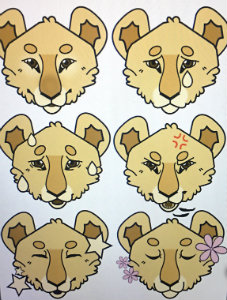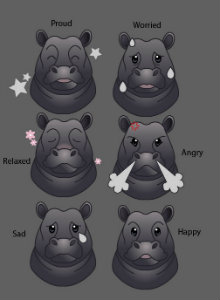How Zoo You Feel? New App Helps Children Learn About Mental Health and Wellness

James M. Loy, Miami University
Listen to the audio podcast
Read the story
Opening up about mental health is something that continues to be a struggle for many. But it can be especially daunting for parents and teachers who are trying to understand the internal lives of young children, particularly those who may not yet know how to best express themselves. Or why they even should.
“There has been a lot of discussion about mental health,” says Raymond Witte, Miami University professor of educational psychology in the College of Education, Health and Society (EHS). “And you can read the papers, you can watch the news, to figure out that we have a long way to go. We are still trying to figure out good ways of tapping into what our young people are feeling and thinking.”
But what if there was an app for that?
 artwork by Grayson James Our growing cultural interest in digital engagement has bred apps that now cover almost every conceivable function. And because contemporary kids are also increasingly accustomed to using smartphones and digital devices, it seemed to Witte, and his team of EHS educational psychology graduate assistants, like such a tool might already exist.
artwork by Grayson James Our growing cultural interest in digital engagement has bred apps that now cover almost every conceivable function. And because contemporary kids are also increasingly accustomed to using smartphones and digital devices, it seemed to Witte, and his team of EHS educational psychology graduate assistants, like such a tool might already exist.
But, it turns out, there’s not an app for that. Not yet, anyway
“We did a pretty big search on apps,” says Sarah Bidwell, EHS graduate student in the department of educational psychology (EDP). “And there was a handful of apps for adults. But we did not find a lot for school-aged children. That was disappointing. So Dr. Witte said, ‘Well, what if we made our own app?’ Then we could tailor it to what we think is important and obviously there is a need out there.”
A need to do more
Most experts would agree. There is a need out there. Issues surrounding mental health and wellness are clearly becoming a concern across society. In fact, “the statistics are staggering,” says Witte.
According to the National Alliance on Mental Illness, nearly 20% of all people in the United States now live with some kind of mental health condition. Approximately 1 in 5 will experience a severe mental disorder at some point in their lives and, overall, only about 1 in 10 will ever receive treatment.
“And kids are no different,” Witte says. “But what’s important is that we can provide good training. Teachers can model good techniques. They can at least have the conversation and that is a start. Because that’s not really been part of the agenda in most classrooms and it needs to be one now.”
So Bidwell, along with fellow EDP graduate students Serena Daley and Molly James, lead a project to create an app-based educational tool that could be used to engage children in an elementary school environment. And after using their knowledge of school psychology to conceptualize a model, they brought their ideas to a group of Miami University computer programing students, who began building the technical components through a cross-campus interdisciplinary collaboration.
“They needed a technology solution for what they wanted, and that’s what our students do,” says Mike Stahr, Miami University computer science and software engineering instructor. “We get students to experience that interfacing with a client. So we look for either projects within the university or outside the university.”
Recently, Stahr’s programming students have worked on apps for major organizations such as KeyBank and even NASA. And like all their projects, the mental health app was similarly coded from the ground up, built with a unique architecture specifically designed to address the concepts advanced by the educational psychology students.
A digital tool for a digital age
The app is called How Zoo You Feel? And since it is meant for children, it will engage young learners through a fun and colorful user-friendly interface.
Children will be able to first choose a cartoon zoo animal avatar, before identifying the emotion that best describes their current feelings. They can choose three positive emotions including “happy,” “proud,” or “relaxed,” Or three negative emotions, which are “sad,” “angry,” or “worried.” Next, a few simple follow-up questions will explore why they might be feeling this way. artwork by Grayson James
artwork by Grayson James
“It is really about opening up,” says Daley. “We want it to open the conversation between kids and adults about their feelings. Our first goal is to make the kids more aware of their emotions as they choose them day-by-day, and to help them understand that it is normal to experience a variety of feelings throughout the week.”
Their responses are also categorized as either external or internal, and then logged in a backend data management system, where the information can be tracked by parents and teachers to help identify any negative emotional trends that might occur over time.
“We’ll start getting some kind of a story about what’s happening for that person,” Witte says. “That’s a great communication bridge for a teacher, who can then start being aware if something is going on. And that can potentially facilitate a conversation at home as well. It gives you at least a little documentation of what’s happening, and then a school psychologist or a counselor could be brought in.”
Creating a conversation
Ideally, the app would be regularly used by an entire class and lead by a teacher who also explains why the activity is important. So alongside identifying any hidden red flags, it’s also about normalizing a conversation around mental health and wellness, and at a much earlier age.
Because even in spite of our growing cultural acknowledgment regarding various issues, many social stigmas and a lack of general awareness still remain. However, Witte believes that new educational tools like How Zoo You Feel? can play a role in overcoming existing cultural barriers.
So one of the app’s larger goals is to simply get everyone more involved, to help children understand that it’s okay to open up about mental health.
“Everyone needs to be educated about good mental health practice,” Witte says “And when teachers do things unilaterally across the classroom, it sends an important message that this is important for everybody and it creates a conversational opportunity to understand a little bit more. And the students realize that if everyone’s doing it, it must be important.”
* How Zoo You Feel? is projected to be available as a free download for parents, teachers, and school districts in the fall of 2018.

